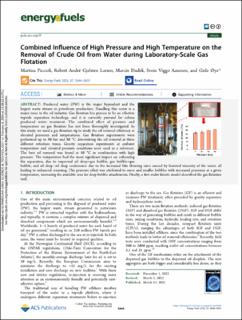| dc.contributor.author | Piccioli, Martina | |
| dc.contributor.author | Gjelsten Larsen, Robert André | |
| dc.contributor.author | Dudek, Marcin Jan | |
| dc.contributor.author | Aanesen, Svein Viggo | |
| dc.contributor.author | Øye, Gisle | |
| dc.date.accessioned | 2024-02-08T13:42:23Z | |
| dc.date.available | 2024-02-08T13:42:23Z | |
| dc.date.created | 2023-03-30T07:48:07Z | |
| dc.date.issued | 2023 | |
| dc.identifier.citation | Energy & Fuels. 2023, . | en_US |
| dc.identifier.issn | 0887-0624 | |
| dc.identifier.uri | https://hdl.handle.net/11250/3116416 | |
| dc.description.abstract | Produced water (PW) is the major byproduct and the largest waste stream in petroleum production. Handling this water is a major issue in the oil industry. Gas flotation has proven to be an effective topside separation technology, and it is currently pursued for subsea produced water treatment. The combined effect of pressure and temperature on gas flotation has not been thoroughly investigated. In this study, we used a gas flotation rig to study the oil removal efficiency at elevated pressures and temperatures. Gas flotation experiments were performed up to 80 bar and 80 °C determining the oil removal at three different retention times. Gravity separation experiments at ambient temperature and elevated pressure conditions were used as a reference. The best oil removal was found at 80 °C in combination with high pressure. The temperature had the most significant impact on enhancing the separation, due to improved oil drop–gas bubble, gas bubble–gas bubble, and oil drop–oil drop coalescence due to the increased film thinning rates caused by lowered viscosity of the water, all leading to enhanced creaming. The pressure effect was attributed to more and smaller bubbles with increased pressures at a given temperature, increasing the available area for drop-bubble attachments. Finally, a first-order kinetic model described the gas flotation well. | en_US |
| dc.language.iso | eng | en_US |
| dc.publisher | ACS | en_US |
| dc.rights | Navngivelse 4.0 Internasjonal | * |
| dc.rights.uri | http://creativecommons.org/licenses/by/4.0/deed.no | * |
| dc.title | Combined Influence of High Pressure and High Temperature on the Removal of Crude Oil from Water during Laboratory-Scale Gas Flotation | en_US |
| dc.title.alternative | Combined Influence of High Pressure and High Temperature on the Removal of Crude Oil from Water during Laboratory-Scale Gas Flotation | en_US |
| dc.type | Journal article | en_US |
| dc.type | Peer reviewed | en_US |
| dc.description.version | publishedVersion | en_US |
| dc.source.pagenumber | 0 | en_US |
| dc.source.journal | Energy & Fuels | en_US |
| dc.identifier.doi | 10.1021/acs.energyfuels.2c04058 | |
| dc.identifier.cristin | 2138333 | |
| cristin.ispublished | true | |
| cristin.fulltext | preprint | |
| cristin.qualitycode | 2 | |

